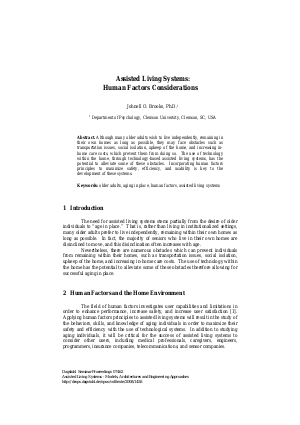Assisted Living Systems: Human Factors Considerations
Author Johnell O. Brooks
-
Part of:
Volume:
Dagstuhl Seminar Proceedings, Volume 7462
Part of: Series: Dagstuhl Seminar Proceedings (DagSemProc) - License:
 Creative Commons Attribution 4.0 International license
Creative Commons Attribution 4.0 International license
- Publication Date: 2008-04-28
File

PDF
DagSemProc.07462.7.pdf
- Filesize: 16 kB
- 2 pages
Document Identifiers
Subject Classification
Keywords
- Older adults
- aging in place
- human factors
- assisted living systems
Metrics
- Access Statistics
-
Total Accesses (updated on a weekly basis)
0PDF Downloads0Metadata Views
Abstract
Although many older adults wish to live independently, remaining in their own homes as long as possible, they may face obstacles such as transportation issues, social isolation, upkeep of the home, and increasing in-home care costs, which prevent them from doing so. The use of technology within the home, through technology-based assisted living systems, has the potential to alleviate some of these obstacles. Incorporating human factors principles to maximize safety, efficiency, and usability is key to the development of these systems.
Cite As Get BibTex
Johnell O. Brooks. Assisted Living Systems: Human Factors Considerations. In Assisted Living Systems - Models, Architectures and Engineering Approaches. Dagstuhl Seminar Proceedings, Volume 7462, pp. 1-2, Schloss Dagstuhl – Leibniz-Zentrum für Informatik (2008)
https://doi.org/10.4230/DagSemProc.07462.7
BibTex
@InProceedings{brooks:DagSemProc.07462.7,
author = {Brooks, Johnell O.},
title = {{Assisted Living Systems: Human Factors Considerations}},
booktitle = {Assisted Living Systems - Models, Architectures and Engineering Approaches},
pages = {1--2},
series = {Dagstuhl Seminar Proceedings (DagSemProc)},
ISSN = {1862-4405},
year = {2008},
volume = {7462},
editor = {Arthur I. Karshmer and J\"{u}rgen Nehmer and Hartmut Raffler and Gerhard Tr\"{o}ster},
publisher = {Schloss Dagstuhl -- Leibniz-Zentrum f{\"u}r Informatik},
address = {Dagstuhl, Germany},
URL = {https://drops.dagstuhl.de/entities/document/10.4230/DagSemProc.07462.7},
URN = {urn:nbn:de:0030-drops-14585},
doi = {10.4230/DagSemProc.07462.7},
annote = {Keywords: Older adults, aging in place, human factors, assisted living systems}
}
